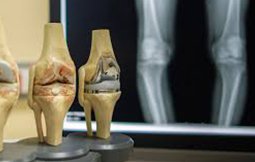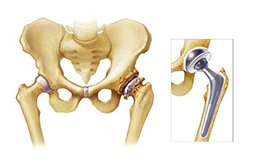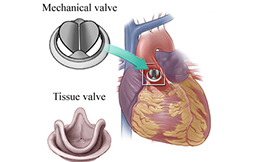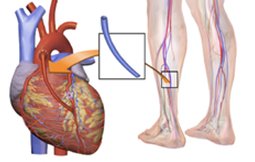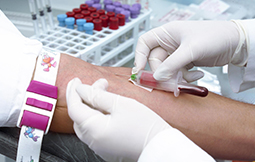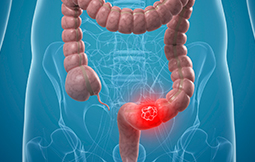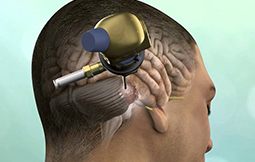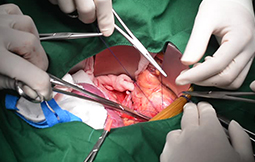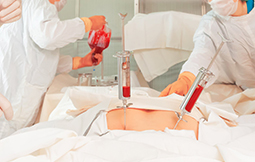Knee replacement is recommended by the doctors if it is hard for the patient to perform simple activities, such as walking or climbing stairs or the knee is harshly damaged by arthritis or injury and they have started feeling pain while sitting or lying down then Knee replacement is the best resort that can help. Knee replacement is one of the most common bone surgeries that usually takes place in people over 50 years of age. When mobility gets extremely painful and irritating after having trying all other options, it is the best resort that can help many. Now most of the top hospitals in India have started using advanced technology in terms of instruments for incision. Owing to this, the incision is smaller when compared to the standard procedure.
Archives: Treatments
Hip Replacement Surgery
Hip replacement surgery is a procedure in which your doctor surgically removes the damaged sections of your hip joint and replaces them with parts usually constructed of metal, ceramic and very hard plastic. This artificial joint (prosthesis) further helps the patient with reduced pain and improved function. This surgery consists of two major types:
• Cemented Prosthesis
• Uncemented Prosthesis
Doctor recommends hip replacement only when the other treatment options have failed as this is the last resort to help a person suffering from hip pain for long.
Spine Surgery
A Spine Surgery is performed to restore and preserve a spine functioning by managing various spinal disorders. This is a surgical specialty that includes both operative and non-operative treatment modalities. A spine surgery is one of the complex surgeries nevertheless; a properly executed surgery can help you restart your daily lifestyle. It is a unique sub-specialty of orthopedic and neurosurgical surgery. The department’s spine specialists offer a range of spinal surgeries with an aim to relieve pain, stabilization of spine and decompression of spinal cord/nerves. But before taking such a major decision, it is important to understand what goes into this surgery.
There are three types of spine surgeries which include:
Cervical Spine Surgery– This is caused by an abnormality in one or more discs – the cushions that lie between the neck bones (vertebrae). This type of surgery is recommended to relieve neck pain, tingling, numbness, and weakness, restore nerve function and stop or prevent abnormal motion in your neck.
Thoracic spine surgery– This surgery is an effective treatment for mid-back pain, but should only be considered if any other treatment options have failed to provide relief. The thoracic spine is the middle area of the back and is made up of twelve vertebrae; T1 through T12.The thoracic spine is the main support sy involved in activities like twisting and bending so if you have any serious issue in the middle area of your back you should consult a doctor as soon as possible.
Lumbar spine surgery – This is a decompression surgery that is used to treat compressed nerves in the lower (lumbar) spine. This surgery is recommended only when non-surgical treatments haven’t helped. This surgery aims to improve symptoms such as constant pain and numbness in the legs caused by pressure on the nerves in the spine.
Brain Tumor Surgery
In brain tumor care, there are different types of surgery and surgeons who use various instruments and methods to remove your brain tumor. In a brain tumor surgery different doctors and surgeons often work together to create a patient’s overall treatment plan that combines different types of treatment. This is called a multidisciplinary team. The procedure for brain tumor surgery involves removing a part of the bone from the patient’s skull for better access to the intracranial part of the brain. Based on where the tumor is located and accessibility of the tumor, the surgery either helps in removing it completely or partially. In cases of partial removal, the patient might also need chemo or radiation posts the brain tumor surgery.
Heart Valve Replacement
Heart valve replacement is a surgery done to repair or replace heart valves that aren’t functioning correctly. Due to the abnormal functioning of the heart valves, there can be a blood flow blockage in the body, which may prove fatal to the patient. In heart valve surgery, the surgeon repairs or replaces the affected heart valves. There are many surgical procedures that may be used to repair or replace heart valves, including open-heart surgery or minimally invasive heart surgery. Your treatment depends on several factors that include your health, age, the condition of the heart valve that is affected and the severity of your condition.
There are two main types of heart valve:
Artificial heart valve– It is a device implanted in the heart of a patient with neurological pathways heart disease. When one of the four heart valves doesn’t function properly, the medical choice may be to replace the natural valve with an artificial valve which requires open-heart surgery. Natural heart valves stimulate unidirectional blood flow through the valve structure from one chamber of the heart to another, so it becomes dysfunctional for a variety of pathological causes, because of which one may require complete surgical replacement of the natural heart valve with an artificial valve.
Mechanical Valve- these types of valves are made of strong durable materials and are the most long-lasting type of replacement valve, and most of these manufactured valves will last throughout the remainder of the patients’ lifetime. The main advantage of placing mechanical valve is their durability as they usually last for the rest of the person’s life. That is why they have been historically favored in cases if younger people with an expected life span of several more decades. However, blood clots can occur in the valve flaps or hinges and result in the malfunctioning of the valve. Which can be an imminently life-threatening situation. Additionally, if these clots break off and travel through the bloodstream or if the clot blocks an artery to the brain, it causes a stroke.
Bypass Surgery
Heart bypass surgery, or coronary artery bypass graft (CABG) surgery, is used to replace damaged arteries to improve blood flow around the blocked or narrow section in the arteries by supplying blood and oxygen to the heart. A surgeon uses blood vessels taken from another area of your body to bypass the damaged arteries. These arteries supply your heart with oxygenated blood. If these arteries are blocked or blood flow is restricted, the heart enables to work properly can lead to heart failure. If you looking for a bypass and want to know the surgery cost in India or have any other questions regarding the surgery, please feel free to contact our doctors and they will provide you with all the necessary details about medical tourism for heart disease in India.
Breast Cancer Surgery
Breast cancer surgery is a key component of breast cancer treatment usually being the first line of attack against cancer. The treatment involves removing cancer with an operation. It may be used alone or in combination with other treatments, such as chemo , hormone , targeted and radiation to prevent cancer from reoccurring in the breasts. Breast cancer has different surgery options that depend on many factors like the stage of cancer, the “personality” of cancer, and what is acceptable to the patient in terms of the long-term peace of mind.
Lumpectomy– In this surgery, the surgeon removes only a portion of the breast tissue. In some cases, even the lymph nodes around the armpits may be removed. It is a partial mastectomy because only a part of the breast tissue is removed. It conserves the breasts to as much extent as possible. This surgery generally takes place in women with small breasts or women with early cancer stages.
Mastectomy – Total Mastectomy is the removal of the entire breasts along with the nipples, areola and sentinel lymph nodes. By opting for a total mastectomy,there are fewer chances of reoccurrence. Partial Mastectomy, is the removal of the cancerous part along with the healthy tissue around. Whereas, lumpectomy is technically a form of partial mastectomy, more tissue is removed in partial mastectomy than in lumpectomy.
Blood Cancer Treatment
Blood cancer takes places when there is a wrong development of blood cells in the blood. It is essentially a set of malignancies that wreaks havoc with the patient’s health and well being and stops them from working properly, often leading to fatality. However, the good news is that the treatment for blood cancer is now readily available and evolving rapidly. While some slow-growing blood cancers can be managed by just taking daily medication, but people with faster-growing acute blood cancers may need stronger (intensive) treatments.The treatment for blood cancer that your doctors recommend will depend on the type of blood cancer you have, your health, and your wishes. You might have just one type of treatment or a number of them orin some cases some people may never need treatment, or will choose not to have treatment.
Colon Cancer Treatment
Colon cancer also called colorectal cancer; it is a disease in which malignant (cancer) cells form in the tissues of the colon or the rectum in a person’s body. Colon Cancer is a serious disease not to be taken lightly and one should take precautions. Treatment for colon cancer is also based largely on the stage (extent) of the cancer, but other factors can also be important. People with colon cancers that have not spread to distant sites usually have surgery as the main or first treatment for Colon cancer. Chemo may also be used in some cases after the surgery (called adjuvant treatment).
Stomach Cancer
Stomach cancer also called gastric cancer is characterized by growth of cancerous cells within the lining of the stomach. These cancer cells can grow and spread in different ways through the wall of the stomach and invade nearby organs. These cancerous cells can further spread to the lymph vessels and nearby lymph nodes (bean-sized structures that help fight infections). The stomach has a very rich group of lymph vessels and nodes. As the stomach cancer becomes more advanced, it can travel through the bloodstream and spread to organs such as the liver, lungs, and bones, which can make it harder to treat. While stomach cancer is relatively rare compared to other types of cancer it is one of the biggest and dangerous disease because of the difficulty of diagnosing it.
Like other cancer treatments stomach cancer treatment is also based on the stage of the cancer. Stomach cancer treatment involves:
- Surgery- A surgery for stomach cancer treatment that involves removal of either a part of the stomach or the whole stomach, an endoscope is used down the throat of the patient in surgery.
- Chemo – Chemo for stomach cancer is the process of treatment through radiation. if there is still lymph of cancer seen in the patient after the surgery it is recommended to go for chemo .
- Targeted – It is one of the most widely used stomach cancer treatment options in top-notch hospitals in India
- Radiation – Ration for stomach cancer is the one in which a patient has to be treated with effective radiation which may be really impactful.
Skull Base Surgery
Skull base surgery is done at the base of the skull and at the top of the first few vertebrae on the spinal cord. It is a procedure done to eliminate cancerous or benign growth and brain abnormalities present in the underside of the brain. Since it is a comparatively a difficult area to reach, this surgery is usually an endoscopic skull base surgery rather than an open surgery. Based on the symptoms, the type of growth and its location, your surgeon will advise the best type of surgery.
Skin Cancer Surgery
Skin cancer is the uncontrolled growth of abnormal skin cells. Skin cancer usually takes place when unrepaired DNA damage to skin cells triggers mutations, or genetic defects, that lead the skin cells to increase rapidly and form malignant tumors. These cells originate from the cells of the epidermis, the superficial layer of the skin.
Mohs surgery
Mohs Surgery was discovered by Mr. Frederick Mohs in 1930s which is one of the most common solutions to treat skin cancer. This surgery is used when there is a high risk that the skin cancer will to come back after treatment, when the extent of the cancer is not known, or when the goal of the treatment is to save as much healthy skin as possible, this may include cancers near the eye or other critical areas such as the central face, ears or fingers. Today, Mohs Surgery is one of the most effective techniques for basal cell carcinoma treatment and squamous cell carcinoma treatment – the two most common skin cancer types.
This surgery is performed by a surgeon with special training. In this procedure, the cancerous cells that are found in the skin are removed layer by layer from the skin until the removed layers show no sign of cancer cells. Mohs surgery is most often used on more visible areas to limit scarring and to ensure minimal damage to healthy skin cells around the affected areas. It is possible to achieve cancer-free margins with this procedure and thus, it is considered as an effective treatment for recurrent skin cancers.
Prostate Cancer
Prostate cancer is generally a slow-growing disease that is diagnosed in men. This treatment is recommended usually for men who have the prostate gland attacked by cancer cells. These cells sometimes spread outside the prostate into nearby or distant parts of the body which can continue to multiply in an uncontrolled way. Removal of the prostate gland or killing or destruction of the cancer cells in the gland is done to treat prostate cancer.
Ovarian Cancer Surgery
Ovarian Cancer Surgery is a procedure for removing the cancerous tumor from the ovaries and is the main line of treatment for most Ovarian cancers. The goal is to see how far your cancer has spread and to remove as much of the tumor as possible through surgery. The extent of surgery is determined by how far cancer has spread in the body and the patient’s general health. In most cases, ovarian cancer treatment involves surgery followed by chemo .
The type of procedure you’ll have depends on the stage of your cancer and your general health. Usually, in this procedure, the surgeon will remove your uterus, ovaries, and both fallopian tubes. She may also need to remove other tissue in your abdomen if cancer has spread in the nearby tissues. To perform the actual surgery your doctor will first diagnose the type, stage, and grade of the cancer and then determine the course of the surgery. If cancer is advanced, the doctor will first perform debulking (removing the tumor as much as possible), followed by chemo .
Ovarian cancer might also spread outside the ovaries which might affect other body parts as well. In such cases, your doctor might have to perform additional surgeries like:
- Splenectomy
- Appendectomy
- Omentectomy (Removal of the fat layers that cover the intestines)
- Cholecystectomy
- Hysterectomy (Removing the Uterus)
- Resection of bowel and/or other structures in the belly
- Lymphadenectomy (elimination of affected lymph glands)
If you are looking for the best ovarian cancer treatment in India, connect with us for detailed information.
Lung Cancer
A lung is a part of the respiratory sy . These lungs are in the chest, placed one on each side of the heart. The right lung has 3 main parts which are called lobes. The left lung is a bit smaller and has only 2 lobes. The lungs are protected and cushioned by a thin layer of covering called the pleura. Lung cancer starts in the cells of the lung when a group of cancer cells cancerous (malignant) tumour grow and destroy the nearby tissue. It can also spread (metastasize) to other organs of the body. When cancer starts in lung cells, it is called as the primary lung cancer.
A Lung cancer treatment is followed by a surgical procedure in which the surgeon which remove all or part of a lung to further removes all the cancerous cells in the tissue. The cells present in the lung sometimes change and no longer grow or behave normally resulting in non-cancerous (benign) tumor such as hamartoma and papilloma. But in some of the cases, changes into the lung cells can cause cancer.
Lung cancers are Broadly classified into non–small cell lung cancer and small cell lung cancer based on the type of cell in which cancer started. Your surgeon will work to remove the lung cancer and a margin of healthy tissue by the following procedures :
- Lobectomy when the surgeon removes any part of the lung.
- Wedge resection when a small section of lung that contains the tumor along with a margin of healthy tissue is removed.
- Pneumonectomy when the surgeon removes the entire lung.
- Sleeve resection when the surgeon removes a larger portion of the lung, but not an entire lobe.
Liver Cancer
Liver cancer is a type of cancer that starts in the liver that is attributed to the uncharacteristic rise in cell reproduction. This treatment includes liver transplant and surgery that is performed when a part of the liver has been infected. Some cancers grow outside the liver and spread to the whole area. However, only cancers that start and develop in the liver are described as liver cancer. The liver is located below the right lung and under the ribcage, is one of the largest organs of the human body that has performs many functions, including removing toxins from the body, and is really important to survival. Just like other cancer treatments, Liver cancer treatment also depends on the stage of the condition.
Lung Transplant
Lung transplant is a surgical procedure in which the surgeon replaces a diseased or failing lung with a healthy lung, usually from a deceased donor. It further helps the patients to breathe easily and grants many more years of life. A lung transplant may involve replacing one of your lungs or both of them, depending on the medical condition of the patient.
Liver Transplant
Liver Transplant is attributed to the uncharacteristic rise in cell reproduction also called Liver cancer. This Surgery is performed when a part of the liver has been infected. Like other cancer treatments, Liver cancer treatment also depends on the stage of the condition. In this case, most of the top hospitals in the country remove just the part that needs attention and use multidisciplinary teams (MDTs). If the whole liver is infected, then the Liver transplant treatment is done. This treatment is replacing a donor’s liver to the patient. Liver cancer treatment is done in cases when the family has a history of liver cancer, excessive consumption of alcohol and smoking, diabetes, liver disease, low immunity etc. are known.
Kidney Transplant
Kidney Transplantation is done when the kidneys stop working, renal failure occurs. Renal or kidney transplants are often recommended to patients with end-stage renal diseases, with an accumulation of toxic waste products in the body. Dialysis or transplantation is required in such cases. Kidney transplant surgery is done when the kidneys that aren’t working well are replaced by a kidney from a donor. In this surgery, kidneys that aren’t working well are replaced by a kidney from a donor to the patient who is suffering through renal failure.
Kidneys for transplantation come from two types of Donor:
The Living Donor:- In India, a living donor must be a family member or blood relative willing to give a kidney to the patient in needs. That person is called a “living donor”
Deceased Donor: – One can also acquire a kidney from a deceased donor who has recently passed on or who has suffered brain death. In this families need to provide permission as well. Once the permission for donation is granted, the kidneys are removed and stored until a recipient has been selected.
Here at Universal Health Help, we offer access to the best kidney transplant surgeons in India. You can connect with them to understand all the medical and legal aspects of visiting India for an organ transplant.
transplant surgeons in India. You can connect with them to understand all the medical and legal aspects of visiting India for an organ transplant.
Bone Marrow Transplant
A bone marrow transplant is a medical procedures performed by transplanting blood cells, i.e. replacing the destroyed and damaged cells with the healthy cells to help your body make enough platelets, white blood cells, or red blood cells to avoid infections, bleeding disorders, or anemia. In this procedure the bone marrow that has been damaged or destroyed are replaced by disease, infection. This procedure involves transplanting blood cells, which move to the bone marrow to further produce new blood cells and promote growth of new marrow.

